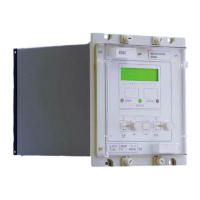Manual
KVCG202/EN M/H
will be 50V dc or 110V ac because these values fall within both of the auxiliary voltage
ranges.
The supply should be connected to terminals 13 and 14 only. To avoid any confusion it is
recommended that the polarity of any applied voltage is kept to the Midos standard:
- for dc supplies the positive lead connected to terminal 13 and the negative to terminal
14.
- for ac supplies the live lead is connected to terminal 13 and the neutral lead to
terminal 14.
3.5.2 Logic control inputs
There are a number of logic control inputs to the relay that are optically coupled to
provide galvanic isolation between the external and internal circuits. They are rated at
48V and the power supply within the relay provides an isolated field voltage to energise
them. This arrangement keeps the power consumption of these inputs to a minimum and
ensures that they always have a supply to energise them when the relay is operational.
Software filtering is applied to prevent induced ac signals in the external wiring causing
operation of logic inputs. This is achieved by sampling the logic inputs eight times per
cycle and five consecutive samples have to indicate that the input is energised in a
positive sense before it is accepted. This ensures that the inputs are relatively immune to
spurious operation from induced ac signals in the wiring. The capture time is:
- 12 ±2.5ms at 50Hz
- 10.4 ±2.1ms at 60Hz
Note: These inputs will not capture a fleeting contact unless it dwells in
the closed state for a time exceeding the above values.
The opto-isolated logic control inputs are divided into two groups: three (L0, L1, L2) have
their common connection on terminal 52 and inputs (L3, L4, L5, L6, L7) have their
common connection on terminal 55. When they are to be energised from the field voltage
then terminals 52 and 55 must be connected to terminal 8, the negative of the field
voltage. The logic inputs can then be energised by connecting a volt free contact
between the positive of the field voltage, terminal 7, and the terminal for the appropriate
logic input.
The circuit for each opto-isolated input contains a blocking diode to protect it from any
damage that may result from the application of voltage with incorrect polarity. Where the
opto-isolated input of more than one relay is to be controlled by the same contact it will be
necessary to connect terminal 7 of each relay together to form a common line. In the
example circuit below, contact X operates L1 of relay 1 and contact Y operates L0 of
relay 1 as well as L0 and L1 of relay 2. L2 is not used on either relay and has no
connections made to it.
The logic inputs can be separated into two isolated groups when it is necessary to
energise some from the station battery. The logic inputs are rated at 48V and it will be
necessary to connect an external resistor in series with the input if the battery is of higher
rated voltage. The value of this resistor should be 2000 ohms for every additional 10V.
The field voltage is not earthed and has insulation rated for 2kV for 1 minute. Therefore,
if necessary the positive terminal of the field voltage could be connected to the positive
terminal of the external battery. Also the two separate groups of logic inputs could be
energised from separate batteries.

